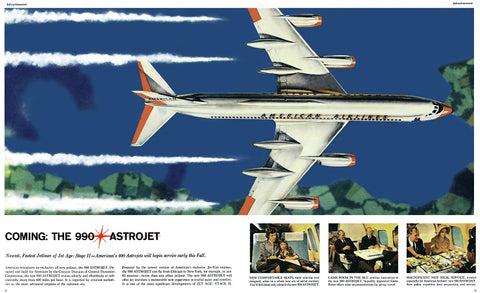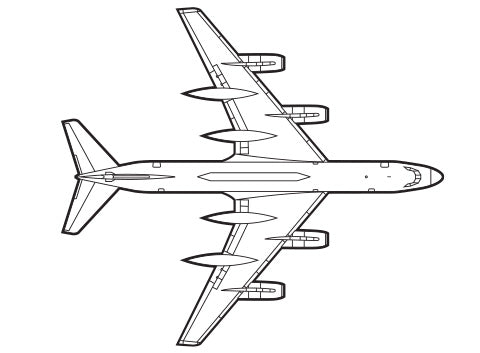
- by Dianna Lopez
Convair 990: A Legacy of Speed
- by Dianna Lopez
A question? Visit our contact page
This site uses cookies for better user experience and analytics.

The Convair 990 was designed to surpass its competition in coast-to-coast flights. It was fast but only 37 were sold, making it arguably the most unsuccessful aircraft in history. Yet, its legacy inspired commercial aviation for decades to come. Keep reading about the Coronado and one in particular that has some interesting stories to tell.

Photo by Ex/zx, used with permission
The Convair 990 (CV 990) Coronado is a narrow body jet airliner with 4 engines, built by the Convair division of General Dynamics. It is a stretched version of the Convair 880, longer than the 880 by 10 feet and capable of carrying 96 - 121 passengers. There were 37 CV-990s produced.
The 990 was produced to meet an American Airlines request for a plane that could fly from New York to Los Angeles against the wind 45 minutes quicker than what was available at the time. Convair guaranteed American Airlines that it could build a plane able to cruise at 635 mph (1,022 km/h). It was designed with more powerful engines, with the addition of a separate fan system in the engine’s exhaust. Many changes were made to counter the transonic drag, such as a new 39 degree swept wing and nacelle fairings, but the 990 did not perform as promised.

American Airlines reduced its initial order, and having never achieved their wish for a speedier coast-to-coast aircraft, began retiring them by 1967. They were also operated by Swiss Air and Scandinavian Airlines (SAS), and eventually found their niche in the charter airlines market. The CV-990 was truly the end of an era for Convair, with only 37 produced. General Dynamics endured a major loss and left the jet airliners to its rivals, eventually finding success and profit building fuselages for McDonnell Douglas, namely the DC-10, KC-10 and MD-11.



CV-990 N8484H was the fifth 990 built for Convair/General Dynamics for flight-test operations. Convair was an American aircraft manufacturing company, formed in 1943 with the merging of Consolidated Aircraft and Vultee Aircraft. It was later purchased by General Dynamics in 1953, and became the Convair Division. They are best known for their military aircraft, rockets, and spacecraft.


After flight test operations with General Dynamics, it was refurbished and sold to APSA. Aerolíneas Peruanas S.A., also known as APSA or Peruvian Airlines (the English translation), operated as the national airline and flag carrier of Peru from 1956 to 1971. APSA was headquartered at Jorge Chávez International Airport in Lima, Peru, and operated scheduled passenger flights to Central and South America, and Los Angeles and Miami.

APSA entered the jet age when it received its first Convair 990 in 1963, OB-R-728. By 1964 they launched the Miami-Lima-Santiago and Miami-Lima-Rio de Janeiro routes, using the CV-990. They leased a second and third CV-990 and continued their expansion. Unfortunately, the airline experienced financial troubles as their debts increased and tax fraud allegations were levied. The government, led by Juan Velasco Alvarado, endeavored to establish Aeroperu, a state-owned airline and refused to bail out APSA. The airline ceased operations in May 1971, with one DC-8-50 and its three CV-990s, including OB-R-728.

Photo by Rods Fotos, used with permission. Taken November 5, 1996
After APSA folded, the plane was flown back to Arizona in 1973. It was reregistered as N990AC and remained stored for several years.

Pictured is NASA's CV-990, by NASA, Public Domain, Link
In 1982, our CV-990 was used for parts for NASA’s 990s. One of them, a highly modified Convair 990, was designated as the Landing Systems Research Aircraft (LSRA) and used between 1993 and 1995 to test space shuttle landing gear assemblies and braking systems. The tests ultimately determined the runway surface at Kennedy Space Center, which allowed a higher crosswind landing limit for the orbiters. The tests took place at NASA’s Dryden Flight Research Center, a “Center of Excellence” for atmospheric flight operations and aeronautical flight research, located near Edwards Air Force Base in California’s Mojave Desert.
Even after being stored for many years, then broken up and used for parts, this 990 continued to serve. While at MHV, between 1990 to 1999, it was used for anti-terrorism training by the FLETC (Federal Law Enforcement Training Center), specifically for dealing with highjacked aircraft on the ground. Interesting to note is that one of APSA’s three CV-990s was hijacked. On January 11, 1969, hijackers took control of the plane after it left Panama City enroute to Miami, and flew it to Cuba. This was just one of dozens of Cuban hijackings during that time period.

MotoArt owner Dave Hall knew immediately when he first saw it that he needed the CV-990 at MHV for the PlaneTags fleet. “The Convair 990 is ultra rare. Only 37 were produced so we were lucky to find this one in our backyard,” says Hall. “Like a lot of our planes, it has such an interesting story. We couldn’t pass it up.”

The team set to work, uncovering a paint texture and a depth of colors that have not been seen on many PlaneTags so far.




The CV-990 PlaneTags are available now at planetags.com. They are numbered in a series of 3,500 and will be offered in a variety of colors and shades. The initial colors will be Metal, Desert Crinkle White, Desert Blue, Desert Colors (a gorgeous mix of shades and textures), and Desert Solid Color.
The colors in this series are some of the most exciting we have ever seen. Because of the rarity of the Coronado, they are sure to become a treasured aircraft in your PlaneTags collection. They are also customizable and can be engraved with a name, address, and phone number to use as a luggage or key tag. And don't forget, they can be personalized with more than that to make a special gift.


Read further about some other Convair aircraft we have worked with.
Convair CV-580: Expanding On Greatness
Convair B-36: An Intercontinental Bomber That Kept The Peace
Fairchild C-82 Packet: The Forgotten Twin-Boom
Before the Flying Boxcar became a military workhorse, Fairchild’s engineers built an ambitious twin-boom transport that paved the way for it. The Fairchild C-82 Packet was a postwar cargo aircraft that promised big things but struggled to live up to them. Although it served for only a few short years, it played an important role in shaping the aircraft that would follow. Today, the legacy of one particular Packet, serial number 44-22991, lives on through MotoArt PlaneTags, preserved from the legendary Soplata Collection.
Born to Last: The Story of the Boeing B-52 Stratofortress
For more than 70 years, the Boeing B-52 Stratofortress has symbolized power, endurance, and innovation in the skies. Born from the Cold War’s demand for a global-range bomber, this legendary aircraft continues to serve generations later. MotoArt now honors that enduring legacy with handcrafted B-52 Coasters, made from authentic aircraft aluminum sourced from Dave Hall’s Mojave boneyard collection. Each coaster is a tangible piece of aviation history, reimagined for collectors who appreciate timeless craftsmanship and the story behind every rivet.
American Airlines DC-10: The Jet That Defined a Generation of Air Travel
The McDonnell Douglas DC-10 marked a new era in American Airlines’ history and the evolution of long-haul travel. Delivered in 1973, aircraft N125AA carried passengers across the globe in polished aluminum and red, white, and blue style before later flying for Hawaiian Airlines. Decades after its final flight, MotoArt rediscovered this DC-10 at Mojave and transformed it into authentic PlaneTags. Each tag preserves a genuine piece of aviation history and celebrates the wide-body jet that defined the golden age of air travel.


Share:
Mikoyan-Gurevich MiG-21 Fishbed: The Supersonic Jet Fighter To Beat
Grumman G-21A Goose: A Legend of Sea and Sky